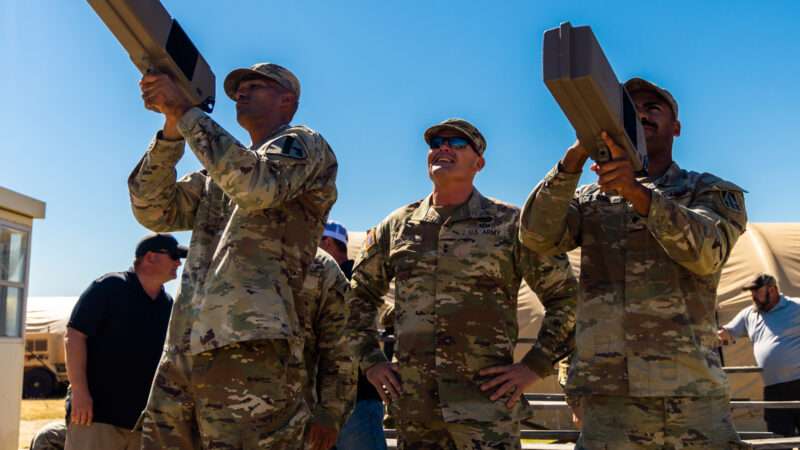
Who owns the airspace over your backyard? In theory, everyone. The Federal Aviation Act of 1958 declared that "a citizen of the United States has a public right of transit through the navigable airspace." That is, everywhere above the trees and buildings.
But it's up to the Federal Aviation Administration (FAA) to set the rules of that navigation. While most of the land area in America is uncontrolled airspace, most of the land where people live falls under controlled airspace, thanks to the amount of air traffic flowing through.
In 2012, Congress asked the FAA to begin regulating drones as aircraft. And in 2020, following changes in the law, the FAA removed the distinction between model planes and drones, classifying both as "unmanned aerial systems." Although aircraft below 0.55 pounds don't have to be registered with the feds, "remote pilots" all have to follow the same rules—including getting control tower permission to fly in controlled airspace.
Remote pilots have to obey the same NOTAMs (short for "notice to air missions") as regular pilots. Most NOTAMs are temporary security restrictions; there is also a permanent NOTAM banning flights over Washington, D.C., and somewhat confusing rules for the airspace around sports games.
On the bright side, the FAA's prerogative over airspace means that other wings of the government can't regulate the air—though some have come up with creative ways around that. Although they can't stop you once you're in the air, the National Park Service and the city of New York both ban drone takeoffs and landings on their turf. St. Louis, meanwhile, has set up a restrictive licensing system for drone businesses.
Reason has compiled a map of cities across America where the skies ain't free. It doesn't include NOTAMs, national security restrictions, stadium no-fly zones, or local regulations. (To get the most up-to-date restrictions, and to get control tower approval to fly in controlled airspace, you may want to use a licensed LAANC app.) You might be surprised at some of these.
Between all the commercial airports—Los Angeles hosts the most airline hubs out of any American city—and the Hollywood private planes, there's not a lot of room for Angeleno remote-control hobbyists. The Reason Foundation's offices are located near LAX: convenient for catching a flight, not so convenient for taking a drone selfie.
Miami has some things in common with Los Angeles: a sunny climate, a party culture, a district called Hollywood. More so than California, South Florida is also home to many private aviation enthusiasts. All that means lots of airports, with lots of controlled airspace around them. Then there's the Everglades, much of which is national parkland, where drone takeoffs are banned.
In the middle of the Everglades sits the Dade-Collier training center, previously known as the Big Cypress Jetport. Built in the late 1960s, the Jetport was slated to be the largest airport in the world, a hub for supersonic jetliners. But mass supersonic aviation never took off, and only one runway was completed. The rest of the airport grounds became the Big Cypress National Preserve.
Central Florida is even worse for flight restrictions. There are lots of airports and military bases around Tampa and Orlando, a permanent no-fly zone over Disney World, and frequent flight restrictions due to space launchers from Cape Canaveral. Your average Florida Man isn't that free to take to the skies.
Knoxville is the "streaking capital of the world" and the namesake of Jackass star Johnny Knoxville, But the skies around it are not exactly naked. Most of downtown is clothed by controlled airspace, thanks to Downtown Island, a general aviation airport. The parks along the Tennessee River, meanwhile, fall under McGhee-Tyson Airport's controlled airspace. Parts of the controlled airspace curve to avoid the Skyranch (a private airfield) and the University of Tennessee hospital helipad.
Oh: And if you want to fly over the Great Smoky Mountains nearby, remember that the National Park Service doesn't allow drone takeoffs.
In the words of the D.C. municipal government, "The airspace around Washington, DC. is more restricted than in any other part of the country." Perhaps more than any other part of the world, even Red Square. Flying a remote-control aircraft within a 15-mile radius of the city is a very good way to get a visit from an unpleasant three-letter agency. It's hard to get a waiver unless you're the Smithsonian—or a government agency spying on protesters.
But some people take the risk. A Canadian drone photographer named Adrien Salv recently posted a video of a drone doing a jerky loop-de-loop around the Washington Monument, which Salv claimed (perhaps not believably) to have found on a memory card lying in the grass. The drone community was not amused by the stunt. "Imagine going to jail for this shitty of a dive," one commenter wrote. There's no word yet on what happened to the pilot.
Speaking of American history, Concord is the home of "the shot heard 'round the world," the opening battle of the American Revolution. But don't think you can celebrate freedom by flying freely through the skies. The bridge where the Battle of Lexington and Concord began is right next to Hanscom Field, home to both a civilian airport and a U.S. Air Force base.
To fly your remote aircraft as freely as possible, you'll want to get as far away from big cities as possible, right? Not so fast. A lot of small towns on the Great Plains have their own municipal airports, with controlled airspace covering the entire town. Aberdeen is just one example.
Dodge City is another one. To fly a drone without FAA approval, you're going to have to get out of Dodge. Literally.
The post Does Uncle Sam Consider Your Backyard Restricted Airspace? appeared first on Reason.com.







